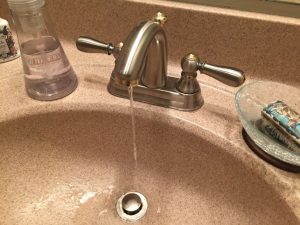Follow these How to tips on Resolving Low Water Pressure
By Mark J. Donovan
|
|
Are you fed up with that weak water stream dribbling out of your shower every morning? A low pressure shower is a frustrating problem that you don’t need to live with. There are a number of easy steps you can take to troubleshoot low water pressure. Moreover, there are a number of solutions you can implement to improve the low water pressure once you’ve discovered the source of the low water force.
Make Sure the Main Water Valve is Fully Open First, if your home is on a municipal water supply make sure the main water valve is fully open. The value is usually located near the water meter. |
If your house recently had contractor work done on it, there’s a possibility that the contractor shut off the water supply for a while, and then did not fully crank the valve open when he restored the water supply.
Check with Your Neighbors
Second, ask your neighbors if they too are experiencing low water pressure. If so, then contact your water utility company to see if they can do something to increase the water pressure in your area.
| Check Your Home’s Water Pressure
Third, check the water pressure in your home. Connect a water pressure gauge up to a hose faucet. With all of the rest of the water valves in the house turned off, with the exception of the main water valve, measure the water pressure in your home’s water supply pipes. Ideally the water pressure should be around 60 PSI. If it is between 40 and 50 PSI, it’s too low. If it’s greater than 70 PSI, then it is too high. |
 |
Check the Water Regulator
Again, if you are on a public water supply, make sure the water regulator is working properly. The regulator drops down the pressure from the main water line to the home. However, if the regulator fails, the pressure could be severely diminished. If you suspect the water regulator is bad, then call your water utility company to have them check it, and replace it if necessary.
| Clear the Clogs at the Faucets/Spigots
Over time minerals can build up in the pipes, and particularly at the faucet outflows. Soak the end of the faucet in vinegar to breakdown the hard minerals that maybe clogging the faucet nozzle. You can do this by partially filling a plastic bag with vinegar and then slipping it over the end of the faucet and holding it in place with a rubber band. After 24 hours, remove the plastic bag filled with vinegar, and then lightly brush the end of the faucet/spigot with an old toothbrush. Then turn on the faucet valves and see if the pressure has improved. |
|
Replace the Plumbing Water Supply Lines
If you have a very old plumbing system in your home, then there is the possibility that the water supply lines themselves are clogged with minerals. If you suspect this is the case, call in a plumber to confirm, and then replace the supply lines if necessary. This is an expensive endeavor, but will most likely need to be done before you can ever sell the home. So there’s no point in living with constant low water pressure. Bite the bullet and spend the money now to restore your home’s normal water pressure.
Check the Well Pump and Water Holding Tank
If you are on a private water system, e.g. you have your own artesian well, make sure the well pump is operating properly and that any whole house water filters are not clogged. Also, it may be necessary to increase the regulator on the water holding tank to a higher pressure, again near 60 PSI.
For information on installing a shower pan membrane liner for a ceramic tile shower, see the Shower Pan Membrane Liner Installation eBook from HomeAdditionPlus.com. The Shower Pan Membrane Liner EBook will quickly teach you the step-by-step process for installing the shower pan membrane liner correctly. It includes instructions on framing the shower stall, pouring the pre-slope and shower base mortar, and installing the shower pan membrane liner.
For information on how to tile a custom ceramic tile shower, see the “How to Tile a Custom Ceramic Tile Shower eBook” from HomeAdditionPlus.com. This eBook will quickly provide you with step-by-step instructions on how to measure and install ceramic tile in a shower, including the installation of tile on shower walls, floors and curbs. It provides detailed instructions for every step in the process of tiling a custom ceramic tile shower and is loaded with instructional pictures!
Related Information
Additional Plumbing Resources from Amazon.com
 |
 |
Get Free Bathroom Remodeling Price Quotes with No Obligation!
Fill out our 3-5 minute quick and easy form, and receive a free price quote on a bathroom remodeling project from one of our pre-screened and licensed bathroom remodeling contractors. This process is free and there is no obligation to continue once you receive your bathroom addition price estimate.
